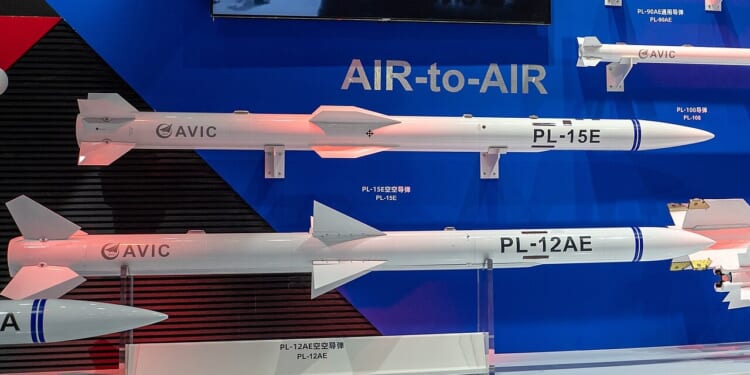During its recent war with Pakistan, India downplayed the effectiveness of the Chinese-made PL-15 missile—but now tacitly acknowledges that effectiveness by seeking to copy it.
When India went to war with neighboring Pakistan, most of the world’s military experts—and the Indians themselves—expected that they would simply walk over the Pakistanis. But the Pakistanis, particularly in the first half of the four-day conflict, surprised the Indian military with their fierce resistance.
This was particularly true of the air war that erupted at the dawn of the conflict.
In that conflict, French Dassault Rafale warplanes, armed with Western missiles, engaged the Pakistani Air Force (PAF) who were sporting Chinese-made J-10Cs and J-17F warplanes that were armed with Chinese-made PL-15 missiles.
Why India Struggled in the Air War Against Pakistan
Those weapons and platforms performed far better against allegedly superior (more expensive) Western systems, sending shockwaves throughout the global arms market.
Since that time, recriminations have roiled. The Indian relationship with France’s Dassault has soured, as the Indians have blamed the platform and the French insinuate that it was poor pilot training that caused the opening phase of India’s war to go sour.
Meanwhile, anyone (such as me) who dared to highlight the surprising failure of India’s forces at the start of the war were smeared throughout the Indian press.
Yet, a new twist to this ongoing silent saga has been revealed.
India (Quietly) Acknowledges That China’s PL-15 Is a Good Weapon
During the four-day conflict, the Indians managed to capture one of the PL-15 missiles that were fired by the PAF but failed to detonate. For months, India’s primary military science group, the Defense Research and Development Organization (DRDO), has studied the captured missile. While the Indian press was claiming the Chinese made weapon was junk and the initial successes Pakistan enjoyed were both overstated and a tactical fluke, the DRDO made a surprising announcement.
According to India’s primary military research organization, the PL-15 isn’t junk after all. Indeed, it is such an impressive system that the Indians are now incorporating aspects of its unique design and makeup into their own indigenously produced Astra missile. The main areas of interest for DRDO was in the PL-15’s miniaturized AESA active-radar seeker/ECCM features, certain guidance and datalink elements, along with design details that inform the propulsion and airframe optimization of China’s powerful air-to-air missile.
Incorporating these features into India’s domestically made Astra missile system will improve its range, kinematics, and jamming resistance.
Why Does the PL-15 Missile Matter for India?
The PL-15 is a long-range, modern “Beyond Visual Range Air-to-Air Missile” (BVRAAM) fielded by China and exported to Pakistan as the PL-15E. By reverse-engineering this intact missile, India’s DRDO is advancing their own research for key subsystems to their Astra missile rather than just simply copying the entire captured PL-15E.
By making Astra more capable, India’s push to be a regional supplier of indigenous weapons while reducing its own reliance on imports for high-end air-to-air missiles enriches India while enhancing the country’s deterrence—not only against Pakistan but, ironically, against neighboring China, too.
Recovering an intact PL-15, which was clearly as good as any of the missiles that the Indians had in their arsenal at the time of the war in May, has given DRDO an invaluable intelligence and engineering windfall. India is using that unprecedented access to accelerate their own Astra seeker, ECCM, and to make other guidance improvements. The end result will be a longer-range, more resilient Astra variant that closes the capability gap with contemporary long-range BVRAAMs in the region.
This news, however, proves how analysts were spot on when they highlighted the surprising way in which Pakistan’s Chinese-made weapons and warplanes performed far better than expected. Hopefully, India can catch up to China in this critical domain and outpace their Pakistani rivals. Still, it will still take time for India to scale these discoveries up—and in that meantime, the geopolitics of the region are rapidly moving against New Delhi.
About the Author: Brandon J. Weichert
Brandon J. Weichert is a senior national security editor at The National Interest. Recently, Weichert became the host of The National Security Hour on America Outloud News and iHeartRadio, where he discusses national security policy every Wednesday at 8pm Eastern. He is also a contributor at Popular Mechanics and has consulted regularly with various government institutions and private organizations on geopolitical issues. Weichert’s writings have appeared in multiple publications, including The Washington Times, National Review, The American Spectator, MSN, The Asia Times, and others. His books include Winning Space: How America Remains a Superpower, Biohacked: China’s Race to Control Life, and The Shadow War: Iran’s Quest for Supremacy. His newest book, A Disaster of Our Own Making: How the West Lost Ukraine is available for purchase wherever books are sold. He can be followed via Twitter @WeTheBrandon.
Image: Wikimedia Commons.


















